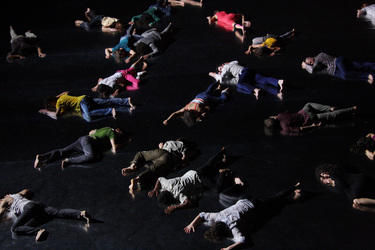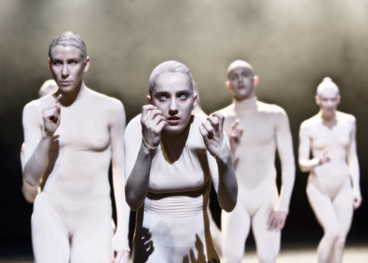 Levée des conflits, photo by Caroline Ablain Levée des conflits, photo by Caroline Ablain As my years as a dance critic pile on, it’s probably to be expected that I see more and more works I’ve already seen. This year, I can think of at least five off the top of my head. The one that most stood up to a repeat viewing was Matija Ferlin and Ame Henderson’s The Most Together We’ve Ever Been. I took the bus to Ottawa to see it just as a snowstorm was hitting the city. The ride ended up taking four hours. I barely had enough time to shove some of the worst food I’ve ever had in my mouth before running over to Arts Court, an old courthouse that has been turned into a beautiful art space. And, as soon as the show started, I knew it was all worth it. Back in Montreal, Israeli choreographer Sharon Eyal made a much-anticipated return after six years with Corps de Walk, a show she created with her partner Gai Behar. The uniformity she imposed on the twelve dancers of Norway’s Carte Blanche was oppressive and disturbing. It was its own indictment of homogeneity. At the Biennale de gigue contemporaine, the always reliable Nancy Gloutnez stood out yet again. With Les Mioles, she borrowed from classical music and became a conductor, turned her dancers’ feet into instruments, and composed a score reminiscent of Steve Reich in its obsessive build-up. After years of being one of the most rigorous emerging choreographers in Montreal, Sasha Kleinplatz has now fully emerged with Chorus II. The audience stood above six male dancers who swayed between demonstrations of physical strength and chill-inducing vulnerability. It is now up to venue artistic directors everywhere to shine on Kleinplatz the spotlight she so clearly deserves. Speaking of which, 2013 was the year of Agora de la danse. They probably had their best programming since I started following dance. It all began with Karine Denault’s Pleasure Dome, in which musicians and dancers explored pleasure without ever lazily resorting to shortcuts. Rather, she allowed the meaning of the work to emerge on its own and for Pleasure Dome to impose itself by the same token. It was followed by When We Were Old, a duo by Québec’s Emmanuel Jouthe and Italy’s Chiara Frigo (presented in collaboration with Tangente). The choreographer-dancers managed to bypass every single contemporary dance cliché that usually occurs as soon as a man and woman are onstage. In each and every moment, their encounter felt fresh and sincere. Agora ended the year with Prismes by Benoît Lachambre, who a month later would win the Montreal Dance Prize. Created for Montréal Danse, Prismes explored the effect of light on perception in a chromatic environment, as well as the fluidity of gender. Lighting designer Lucie Bazzo outdid herself for this highly experiential work. At the Festival TransAmériques, it was French choreographer Boris Charmatz who stood out with Levée des conflits, an opus of twenty-five movements repeated as a canon by twenty-four dancers. From the simplicity of the choreography to the high number of performers, Levée des conflits impressively hovered between minimalism and excess. I spent the summer in Iceland, where my trip ended with the Reykjavík Dance Festival. There, Norway’s Sissel M Bjørkli presented one of the most singular shows I’ve ever seen with Codename: Sailor V. It took place in a tiny space, barely big enough to seat fifteen. The smoke that filled the room along with Elisabeth Kjeldahl Nilsson and Evelina Dembacke’s intensely saturated coloured lighting blurred the edges of everything. Inspired by anime, Bjørkli created an alter ego for herself and through imaginative play managed to turn an office chair into a spaceship. That shit was magical. So was Nothing’s for Something by Belgium’s Heine Avdal and Yukiko Shinozaki, which opened with a ballet for six curtains, each suspended by six huge helium-filled balloons. Set to classical music, it was reminiscent of Disney’s Fantasia. For its finale, eight such balloons were left to float around the room while emitting breathing sounds, appearing like disembodied alien visitors. Soon after my return to Montreal, Marie Chouinard presented Henri Michaux : Mouvements. The genesis of this work, when Carol Prieur first incarnated the drawings of Henri Michaux back in 2005, is the reason why I’m a dance critic today. Seeing the twelve dancers of Chouinard’s company lend themselves to the exercise was just as riveting eight years later. By translating drawings into movement, Chouinard demonstrated the power of dance to think the body creatively. Usine C ended the year on a high note with their program from the Netherlands, most especially Ann Van den Broek’s feminist work for three female dancers, Co(te)lette. The show was powerful in its exposition of women’s bodies as a site of tension, torn between being objects of desire and embodied subjects. We can only hope that there will be more works like it in 2014.
0 Comments
 Corps de Walk, photo by Erik Berg You might be hearing animal sounds, but human beings are already somewhere else. They are no longer a manifestation of life itself; they have taken it and placed it outside of themselves. It’s now in the nature around them, the nature that used to inhabit them, and in the heavens above. At the beginning of choreographer Sharon Eyal and Gai Behar’s Corps de Walk, the twelve Carte Blanche dancers lift their arms up to the sky like they’re in Alvin Ailey’s Revelations. However, while in the latter the performers couldn’t be more earnest, here something is already off. It reads like parody. By spiritualizing themselves, human beings have become more disembodied, less animal, less human. In her previous show presented in Montreal, Bertolina, Eyal already offered us a microcosm of human society, though in this former vision each was still allowed to retain some individuality. Here, differences are eradicated until uniformity takes over both their appearance and movement. It’s at first funny, then unsettling, and eventually nightmarish. From robots to ballet dancers, there’s only one step. They go there. By dehumanizing themselves, human beings end up parodying themselves. In Corps de Walk, uniformity and synchronicity reach obsessive heights, falling into sci-fi horror territory. Think Village of the Damned, The Stepford Wives, Invasion of the Body Snatchers, and any other movie where a single entity controls multiple bodies. The resulting creatures are androgynous and beige, desexualized, deracialized. Their bodies, overly controlled, are troubling. A dancer shouts: “Now”? Their synchronicity is regimented from the outside, dictated military-style. Obedience is necessary; and disturbing. They are a mindless herd. The togetherness does not feed them; it feeds off them. As opposed to Karine Denault’s Pleasure Dome or Anne Teresa De Keersmaeker’s Cesena, they are but empty vessels. In Denault’s show, you witnessed the ego fade away; here, it is the self itself that is eradicated. The oppression is claustrophobic. On the rare occasions when a dancer escapes the group to execute their own movement, it is liberating; but they inevitably get swallowed back into the mass. (After the show, I heard an astute audience member compare it to Jean-Pierre Perreault’s work.) Dance music blasts over the speakers. As the lights slowly fade, the dancers (barely) move to the beat in a tight formation. They are zombies at the club. Just do like everybody else. Don’t bring any attention to yourself. Don’t stand out. Don’t be. February 28-March 2 at 8pm Danse Danse / Théâtre Maisonneuve www.dansedanse.net / laplacedesarts.com 514.842.2112 / 1.866.842.2112 Tickets: 34,85$-62,34$ |
Sylvain Verstricht
has an MA in Film Studies and works in contemporary dance. His fiction has appeared in Headlight Anthology, Cactus Heart, and Birkensnake. s.verstricht [at] gmail [dot] com Categories
All
|
 RSS Feed
RSS Feed